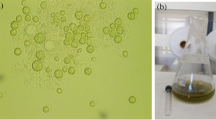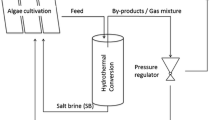Abstract
Axenic culture of microalgae Chlorella vulgaris ATCC® 13482 and Scenedesmus obliquus FACHB 417 was used for phycoremediation of primary municipal wastewater. The main aim of this study was to measure the effects of normal air and CO2-augmented air on the removal efficacy of nutrients (ammonia N and phosphate P) from municipal wastewater by the two microalgae. Batch experiments were carried out in cylindrical glass bottles of 1 L working volume at 25 °C and cool fluorescent light of 6500 lux maintaining 14/10 h of light/dark cycle with normal air supplied at 0.2 L min−1 per liter of the liquid for both algal strains for the experimental period. In the next set of experiments, the treatment process was enhanced by using 1, 2 and 5% CO2/air (vol./vol.) supply into microalgal cultures. The enrichment of inlet air with CO2 was found to be beneficial. The maximum removal of 76.3 and 76% COD, 94.2 and 92.6% ammonia, and 94.8 and 93.1% phosphate after a period of 10 days was reported for C. vulgaris and S. obliquus, respectively, with 5% CO2/air supply. Comparing the two microalgae, maximum removal rates of ammonia and phosphate by C. vulgaris were 4.12 and 1.75 mg L−1 day−1, respectively, at 5% CO2/air supply. From kinetic study data, it was found that the specific rates of phosphate utilization (q phsophate) by C. vulgaris and S. obliquus at 5% CO2/air supply were 1.98 and 2.11 day−1, respectively. Scale-up estimation of a reactor removing phosphate (the criteria pollutant) from 50 MLD wastewater influent was also done.




Similar content being viewed by others
References
Abou-Shanab RAI, Ji MK, Kim HC, Paeng KJ, Jeon BH (2013) Microalgal species growing on piggery wastewater as a valuable candidate for nutrient removal and biodiesel production. J Environ Manage 115:257–264
Ahmad MN, Holland CR (1995) Growth kinetics of single-cell protein in batch fermenters. J Food Eng 26:443–452
Allowable Limits for Trade Effluent Discharge to Sewer/Watercourse/Controlled Watercourse, Public Utilities Board Singapore. http://www.nea.gov.sg/anti-pollution-radiation-protection/water-pollution-control/allowable-limits. Accessed 05 Jan 2017
APHA (2005) Standard methods for the examination of water and wastewater. American Public Health Association, Washington, DC
Bashan L, Bashan Y (2004) Recent advances in removing phosphorus from wastewater and its future use as fertilizer (1997–2003). Water Res 38:4222–4246
Becker EW (1994) Microalgae biotechnology and microbiology. Cambridge University Press, Cambridge
Bitton G (1990) Wastewater microbiology. Wiley-Liss, New York
Bolan NS, Wong L, Adriano DC (2004) Nutrient removal from farm effluents. Bioresour Technol 94:251–260
Bold’s Basal medium. Culture Collection of Algae and Protozoa, Dunstaffnage Marine Laboratory, Oban, Argyll, PA37 1QA, UK. http://www.ccap.ac.uk/media/documents/BB.pdf. Accessed 14 Feb 2016
Cardozo KHM, Guaratini T, Barros MP, Falcao VR, Tonon AP, Lopes NP, Campos S, Torres MA, Souza AO, Colepicolo P, Pinto E (2007) Metabolites from algae with economical impact. Comp Biochem Physiol Part C Toxicol Pharmacol 146(1–2):60–78
Carlsson AS, Clayton D, Moeller R, van Beilen JB JB (2007) Micro- and macro-algae: utility for industrial applications. EPOBIO Project, Newbury
Central Pollution Control Board. The Environment (Protection) Rules, Government of India (1986). http://cpcb.nic.in/GeneralStandards.pdf. Accessed 18 Jan 2017
Chevalier P, Proulx D, Lessard P, Vincent WF, de la Noüe J (2000) Nitrogen and phosphorus removal by high latitude mat-forming cyanobacteria for potential use in tertiary wastewater treatment. J Appl Phycol 12:105–112
Chisti Y (2007) Biodiesel from microalgae. Biotech Adv 25:294–306
Christenson LB, Sims RC (2012) Rotating algal biofilm reactor and spool harvester for wastewater treatment with biofuels by-products. Biotechnol Bioeng 109(7):1674–1684
Costa JAV, Colla LM, Duarte P (2003) Spirulina platensis growth in open raceway ponds using fresh water supplemented with carbon, nitrogen and metal ions. J Biosci 58:76–80
Cuellar-Bermudez SP, Garcia-Perez JS, Rittmann BE, Parra-Saldivar R (2015) Photosynthetic bioenergy utilizing CO2: an approach on flue gases utilization for third generation biofuels. J Clean Prod 98:53–65
De-Bashan LE, Moreno M, Hernandez J, Bashan Y (2002) Removal of ammonium and phosphorus ions from synthetic wastewater by the microalgae Chlorella vulgaris coimmobilized in alginate beads with the microalgae growth-promoting bacterium Azospirillum brasilense. Water Res 36:2941–2948
Discart V, Bilad MR, Marbelia L, Vankelecom IFJ (2014) Impact of changes in broth composition on Chlorella vulgaris cultivation in a membrane photobioreactor (MPBR) with permeate recycle. Bioresour Technol 152:321–328
Dunn K (1998) The Biotechnology of high rate algal ponding systems in the treatment of saline tannery wastewaters. Ph.D. thesis. Rhodes University, Grahamstown, South Africa
Feng Y, Li C, Zhang D (2011) Lipid production of Chlorella vulgaris cultured in artificial wastewater. Bioresour Technol 102:101–105
Fewtrell L (2004) Drinking-water nitrate, methemoglobinemia, and global burden of disease: a Discussion. Environ Health Perspect 112(4):1371–1374
Gantar M, Obreht Z, Dalmacija B (1991) Nutrient removal and algae succession during the growth of Spirulina platensis and Scenedesmus quadricauda on swine wastewater. Bioresour Technol 36:167–171
Garcia J, Green BF, Lundquist T, Mujeriego R, Hernández-Mariné M, Oswald WJ (2006) Long term diurnal variations in contaminant removal in high rate ponds treating urban wastewater. Bioresour Technol 97:1709–1715
Guzzon A, Bohn A, Diociaiuti M, Albertano P (2008) Cultured phototrophic biofilms for phosphorus removal in wastewater treatment. Water Res 42:4357–4367
Halling-Sørensen B, Jørgensen SG (1993) The removal of nitrogen compounds from wastewater, vol 54, 1st edn. Elsevier, Dordrecht
Hammouda O, Gaber A, Abdel-Raouf N (1994) Microalgae and wastewater treatment. Ecotoxic Environ Saf 31:205–210
Herzog H, Golomb D (2004) Carbon capture and storage from fossil fuel use. Encyclopedia of Energy 1:1–11
Hillebrand H, Sommer U (1999) The nutrient stoichiometry of benthic microalgal growth: redfield proportions are optimal. Limnol Oceanogr 44:440–446
Ji MK, Abou-Shanab RAI, Kim SH, Salama E, Lee SH, Kabra AN, Lee YS, Hong S, Jeon BH (2013) Cultivation of microalgae species in tertiary municipal wastewater supplemented with CO2 for nutrient removal and biomass production. Eco Eng 58:142–148
Kumar K, Dasgupta CN, Nayak B, Lindblad P, Das D (2011) Development of suitable photobioreactors for CO2 sequestration addressing global warming using green algae and cyanobacteria. Bioresour Technol 102:4945–4953
Larsdotter K (2006) Wastewater treatment with microalgae—a literature review. VATTEN 62:31–38
Lau PS, Tam NFY, Wong YS (1996) Wastewater nutrients removal by Chlorella vulgaris: optimization through acclimation. Environ Technol 17(2):183–189
Lee YK (2001) Microalgal mass culture systems and methods: their limitation and potential. J Appl Phycol 13:307–315
Lefyedi ML, Taylor JRN (2012) Effect of dilute alkaline steeping on the microbial contamination, toxicity and diastatic power of Sorghum malt. J Inst Brew 112(2):108–116
Levenspiel O (2000) Chemical Reaction Engineering, 3rd edn. Editora Edgard Blucher Ltd., Sao Paulo, pp 34–120
Lundquist T, Benemann J (2007) Using algae and CO2 to treat wastewater and produce biofuel feedstock. http://www2.bren.ucsb.edu/~keller/energy-water/4-2%20Tryg%20Lundquist.pdf. Accessed 14 Jan 2017
Martinez ME, Sanchez S, Jimenez JM, Yousfis FE, Munoz L (2000) Nitrogen and phosphorus removal from wastewater by the microlaga Scenedesmus obliquus. Bioresour Technol 73:263–272
McGinn PJ, Dickinson KE, Park KC, Whitney CG, MacQuarrie SP, Black FJ, Frigon JC, Guiot SR, O’Leary SJB (2012) Assessment of the bioenergy and bioremediation potentials of the microalga Scenedesmus sp. AMDD cultivated in municipal wastewater effluent in batch and continuous mode. Algal Res 1:155–165
Milledge JJ (2011) Commercial application of microalgae other than biofuels: a brief review. Rev Environ Sci Bio/Technol 10:31–41
Minnesota Pollution Control Agency (2008). Nutrients: phosphorus, nitrogen sources, impact on water quality—a general overview. Water Qual 3(22):1–2. https://www.pca.state.mn.us/sites/default/files/wq-iw3-22.pdf. Accessed 01 Jan 2017
Mulbry W, Kondrad S, Buyer J (2008) Treatment of dairy and swine manure effluents using freshwater algae: fatty acid content and composition of algal biomass at different manure loading rates. J Appl Phycol 20:1079–1085
Muñoz R, Guieysse B (2006) Algal-bacterial processes for the treatment of hazardous contaminants: a review. Water Res 40:2799–2815
Nagase H, Yoshihara K, Eguchi K, Okamoto Y, Murasaki S, Yamashita R, Hirata K, Miyamoto K (2001) Uptake pathway and continuous removal of nitric oxide from flue gas using microalgae. Biochem Eng J 7:241–246
National Environment Agency (2016) Allowable limits for trade effluents discharge to sewer/watercourse/controlled watercourse. Public Utilities Board, Singapore
Nilsson C, Renman G, Westholm LJ, Renman A, Drizo A (2013) Effect of organic load on phosphorus and bacteria removal from wastewater using alkaline filter materials. Water Res 47:6289–6297
Nunez VJ, Voltolina D, Nieves M, Pina P, Medina A, Guerrero M (2001) Nitrogen budget in Scenedesmus obliquus cultures with artificial wastewater. Bioresour Technol 78:161–164
Nurdogan Y, Oswald WJ (1995) Enhanced nutrient removal in high rate ponds. Water Sci Technol 31:33–43
Olaizola M (2003) Commercial development of microalgal biotechnology: from the test tube to the marketplace. Biomol Eng 20:459–466
Olaizola M, Bridges T, Flores S, Griswold L, Morency J, Nakamura T (2004) Microalgal removal of CO2 from flue gases: CO2 capture from a coal combustor. Department of Energy, Colorado
Oliver RL, Ganf GG (2000) Freshwater blooms. In: Whitton BA, Potts M (eds) The ecology of cyanobacteria: their diversity in time and space. Kluwer, Dordrecht, pp 149–194
Oswald WJ (1988) Micro-algae and wastewater treatment. In: Borowitzka MA, Borowitzka LJ (eds) Micro-algal biotechnology. Cambridge University Press, Cambridge, pp 305–328
Oswald WJ (2003) My sixty years in applied algology. J Appl Phycol 15:99–106
Packer M (2009) Algal capture of carbon dioxide; biomass generation as a tool for greenhouse gas mitigation with reference to New Zealand energy strategy and policy. Energy Policy 37:3428–3437
Park JBK, Craggs RJ, Shilton AN (2011) Wastewater treatment high rate algal ponds for biofuel production. Bioresour Technol 102:35–42
Queiroz MI, Lopes EJ, Zepka LQ, Bastos RG, Goldbeck R (2007) The kinetics of removal of nitrogen and organic matter from parboiled rice effluent by cyanobacteria in a stirred batch reactor. Bioresour Technol 98:2163–2169
Rao PH, Kumar RR, Raghavan BG, Subramanian VV, Sivasubramanian V (2011) Application of phycoremediation technology in the treatment of wastewater from leather-processing chemical manufacturing facility. Water SA 37(1):7–14
Sedlak R (1991) Phosphorus and nitrogen removal from municipal wastewater: principles and Practice, 2nd edn. Lewis Publisher, Ann Arbor
Suryata I, Svavarsson HG, Einarsson S (2010) Geothermal CO2 bio-mitigation techniques by utilizing microalgae at the Blue Lagoon, Iceland. In: Proceedings at 34th workshop on geothermal reservoir engineering, Stanford, California
Sydney EB, da Silva TE, Tokarski A, Novak AC, de Carvalho JC, Woiciecohwski AL, Larroche C, Soccol CR (2011) Screening of microalgae with potential for biodiesel production and nutrient removal from treated domestic sewage. Appl Energy 88:3291–3294
Tam NFY, Wong YS (2000) Effect of immobilized microalgal bead concentrations on wastewater nutrient removal. Environ Pollut 107:145–151
United States Environmental Protection Agency (USEPA) (2016) Nutrient pollution: the problem. https://www.epa.gov/nutrientpollution/problem
Woertz I, Feffer A, Lundquist T, Nelson Y (2009) Algae grown on dairy and municipal wastewater for simultaneous nutrient removal and lipid production for biofuel feedstock. J Environ Eng (ASCE) 135(11):1115–1122
Zhang E, Wang B, Wang Q, Zhang S, Zhao B (2008) Ammonia-nitrogen and orthophosphate removal by immobilized Scenedesmus sp. isolated from municipal wastewater for potential use in tertiary treatment. Bioresour Technol 99:3787–3793
Acknowledgements
The present research study was supported by the National Research Foundation (NRF), Prime Minister’s Office Singapore, under its Campus for Research Excellence and Technological Enterprise (CREATE) program. The first author is very grateful to thank National University of Singapore for hosting his doctoral research under the Joint-Ph.D. Programme between Indian Institute of Technology Bombay and National University of Singapore.
Author information
Authors and Affiliations
Corresponding author
Additional information
Editorial responsibility: Xu Han
Electronic supplementary material
Below is the link to the electronic supplementary material.
Rights and permissions
About this article
Cite this article
Chaudhary, R., Tong, Y.W. & Dikshit, A.K. CO2-assisted removal of nutrients from municipal wastewater by microalgae Chlorella vulgaris and Scenedesmus obliquus . Int. J. Environ. Sci. Technol. 15, 2183–2192 (2018). https://doi.org/10.1007/s13762-017-1571-0
Received:
Revised:
Accepted:
Published:
Issue Date:
DOI: https://doi.org/10.1007/s13762-017-1571-0




